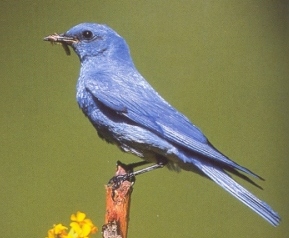|

Small thrush with
brilliant blue back, head, and wings. Throat and breast are paler blue,
and belly and undertail coverts are white. Hovers more than other bluebirds
and drops on prey from above, also catches insects in flight.
Eats mostly insects in the summer.
|
MOUNTAIN
BLUEBIRD
Sialia currucoides
PASSERIFORMES
Thrushes (Turdidae)
Range
and Habitat
Mountain Bluebird: Breeds in open habitats in southern Alaska, Mackenzie,
and Manitoba south to western Nebraska, New Mexico, Arizona, and southern
California. Spends winters in British Columbia and Montana south through
western U.S. Inhabits high mountain meadows with scattered trees and
bushes; in winter, descends to lower elevations in plains and grasslands.
SOUND:
"tru-lee", "phew"
Mountain
Bluebirds can be seen hovering in the air, in a hawk-like manner, a
meter or more above the ground searching
for a food item. They are partial to insects—studies indicate
that up to 92% of their diet is composed of animal matter.
It is the state bird of Idaho and Nevada.
A group of thrushes are collectively known as a
"hermitage" and a "mutation" of thrushes.
 
The Mountain Bluebird has a large range, estimated globally at 4,400,000
kilometers. Native to Canada, the United States, and Mexico, this bird
prefers grassland, forest, and shrubland ecosystems. The global population
of this bird is estimated at 5,200,000 individuals and does not show
signs of decline that would necessitate inclusion on the IUCN Red List.
|